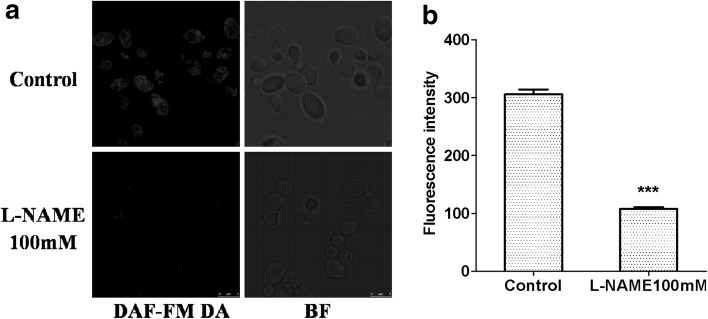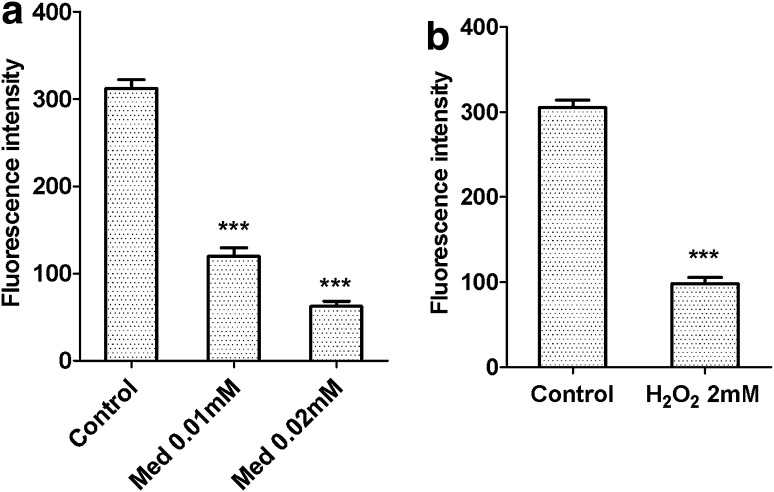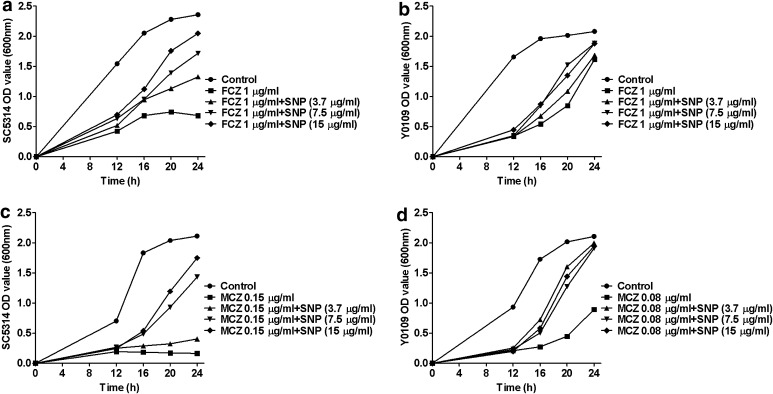Abstract
Nitric oxide (NO) is a small molecule with a wide range of biological activities in mammalian and bacteria. However, the role of NO in fungi, especially Candida albicans, is not clear. In this study, we confirmed the generation of endogenous NO in C. albicans, and found that the production of endogenous NO in C. albicans was associated with nitric oxide synthase pathway. Our results further indicated that the production of endogenous NO in C. albicans was reduced under oxidative stress such as menadione or H2O2 treatment. Meanwhile, exogenous NO donor, sodium nitroprusside (SNP), synergized with H2O2 against C. albicans. Interestingly, SNP could inhibit the antifungal effect of azoles against C. albicans in vitro, suggesting that NO might be involved in the resistance of C. albicans to antifungals. Collectively, this study demonstrated the production of endogenous NO in C. albicans, and indicated that NO may play an important role in the response of C. albicans to oxidative stress and azoles.
Keywords: Nitric oxide, Candida albicans, Oxidative stress, Azoles
Introduction
Candida albicans is one of the most common opportunistic fungal pathogens of humans, which can cause invasive infections with high mortality rate in immunocompromised individuals [1–3]. An important fungicidal mechanism employed by innate immune cells involves the generation of reactive oxygen species (ROS), such as H2O2. Nevertheless, C.albicans employed strategies to evade the oxidative killing by innate immune cells [4]. The need for effective antifungal therapy is increasing. However, available antifungal agents are limited up to now. Azoles, fluconazole (FCZ) for example, are still widely used in clinic [5, 6]. With the increasing use of the azoles, drug resistance has become a significant challenge [7, 8]. The high mortality rate of invasive infections and increasing drug resistance of C. albicans make it significant to study the oxidative stress response and drug resistance mechanisms of C. albicans [9].
Nitric oxide (NO) is a highly diffusible free radical, which is acknowledged as an intra- and inter-cellular signaling molecule in both animals and plants [10, 11]. In mammals, NO acts as a critical regulator in nervous, immune and cardiovascular systems [12], and an important mediator in certain pathophysiologic conditions [13]. NO in animals is synthesized by a family of enzymes, known as nitric oxide synthases (NOS), which catalyze the conversion of the amino acid l-arginine to NO and l-citrulline [14]. In plants, algae, and fungi, no true NOS homologs has yet been identified. Nevertheless, there have been a number of publications reporting the existence of NOS-like effect in bacteria [15, 16], yeast [17, 18], and plants [19]. Notably, the production and physiological activity of the bacterial endogenous NO has been deeply studied. It was reported that bacterial NOS are present in many gram-positive species, which could increase the resistance of bacteria to a broad spectrum of antibiotics, enable the bacteria to survive and share habitats with antibiotic-producing microorganisms [15, 20]. However, whether there is endogenous NO in C. albicans is unclear, and few study has focused on the role of NO in C. albicans up to now.
In this study, we focused on the production of endogenous NO in C. albicans, and explored the effects of NO on the antifungal activity of oxidative stress and azoles against C. albicans.
Materials and Methods
Strains and Media
Candida albicans strains SC5314 and Y0109 were used in this study. Strains were routinely grown in YPD (1 % yeast extract, 2 % peptone, and 2 % dextrose) liquid medium at 30 °C in a shaking incubator. DAF-FM DA (diaminofluorescein-FM diacetate) and l-NAME (N-Nitro-l-arginine Methyl Ester, Hydrochloride) were purchased from Beyotime Institute of Biotechnology. Sodium nitroprusside (SNP) FCZ and Miconazole (MCZ) were purchased from Sigma.
Measurement of NO in C. albicans
The intracellular levels of NO were assessed using the NO-selective probe DAF-FM DA. Exponentially growing C. albicans cells were harvested, washed and resuspended in PBS. After addition of a specific NOS inhibitor l-NAME (100 mM), cell suspensions were incubated at 30 °C under constant shaking (200 rpm) for 1 h [21]. Control group was incubated without l-NAME treatment. C. albicans cells were then harvested, washed, and resuspended in PBS containing 5 μM DAF-FM DA, pH 7.4, and incubated at 37 °C for 20 min [22]. After the incubation, cells were washed three times and resuspended in PBS. Living cells were immobilized on 0.1 % poly-l-lysine-coated slides, and observed under a Leica TCS SP2 confocal microscope equipped with argon and helium–neon lasers (Leica, Germany). The mean fluorescence intensity of 10,000 cells per sample was measured by flow cytometry.
Time-Kill Curve Assay
Exponentially growing C. albicans cells were harvested and resuspended in fresh YPD medium to 5 × 104 cells/ml. Various concentrations of antifungal agents were added. The cells were cultured at 30 °C under constant shaking (200 rpm), and OD600 was measured at the designated time points (0, 12, 16, 20, 24 h). No antifungal agent was added in the control group. Three independent experiments were performed.
Results
NO Production in C. albicans
To date, NO production has not been reported in C. albicans. Therefore, we initially investigated the production of endogenous NO in C. albicans. A NO-selective probe DAF-FM DA, which has been successfully used to detect NO production in yeast was used in this study [18]. After incubation with DAF-FM DA, C. albicans showed bright fluorescence under confocal microscope, indicating NO production (Fig. 1a). Notably, after treatment with 100 mM NOS inhibitor l-NAME, no observable fluorescence was found (Fig. 1a). The mean fluorescence intensity indicating NO was measured by flow cytometry. In accordance with the observation under confocal microscope, after treatment with l-NAME, NO production was reduced by 65 % (P < 0.001, Fig. 1b). Collectively, these findings suggested that NO could be produced by C. albicans, and the NO production was associated with a NOS-like biological effect.
Fig. 1.
Intracellular NO fluorescence of C. albicans SC5314 treated with 100 mM l-NAME or not. a Fluorescence of intracellular NO. DAF-FM DA, fluorescence field; BF, bright field. b The fluorescence intensity of intracellular NO was observed with excitation at 485 nm and emission at 525 nm. Statistical significance between two groups was determined by Student t test. The data are shown as means ± SDs from three independent experiments. ***P < 0.001
NO is Involved in the Response of C. albicans to Oxidative Stress
We further detected the generation of endogenous NO in C. albicans under oxidative stress. C. albicans were exposed to menadione and H2O2 respectively. The results indicated that the generation of endogenous NO in C. albicans was significantly inhibited by menadione and H2O2 (P < 0.001, Fig. 2). We further investigated the effects of exogenous NO on oxidative stress response of C. albicans. SNP, a specific NO donor [21] was used in this work. Although 2 mM H2O2 could inhibit the growth of C. albicans to some degree, SNP ranging from 3.7 to 7.5 μg/ml didn’t show significant antifungal effect (Fig. 3). Interestingly, the combination of 3.7 μg/ml SNP and 2 mM H2O2 killed C. albicans completely (Fig. 3b). Collectively, our results showed that the generation of endogenous NO in C. albicans could be inhibited by oxidative stress and exogenous NO could synergize with H2O2 against C. albicans.
Fig. 2.
Intracellular NO fluorescence intensity of C. albicans SC5314 treated with menadione (Med) or H2O2. The fluorescence intensity was observed with excitation at 485 nm and emission at 525 nm. Statistical significance between two groups was determined by Student t test. The data are shown as means ± SDs from three independent experiments. ***P < 0.001
Fig. 3.
Time-kill curves of C. albicans SC5314 with the treatment of different concentrations of SNP and H2O2
NO Protects C. albicans Against Azoles
Furthermore, we investigated the effects of exogenous NO on the antifungal effect of azoles. Unexpectedly, exogenous NO could attenuate the antifungal effect of azoles. As shown in Fig. 4a and c, 1 μg/ml FCZ or 0.15 μg/ml MCZ could inhibit the growth of C. albicans SC5314 significantly. However, the addition of 3.7 μg/ml SNP attenuated the antifungal effect of azoles. Moreover, with the concentration of SNP increasing, the effect was more obvious (Fig. 4a, c). To confirm this finding, another clinical C. albicans strain Y0109 was used, and the results were consistent with the finding on C. albicans SC5314 (Fig. 4b, d).
Fig. 4.
Time-kill curves of C. albicans SC5314 or Y0109 with the treatment of different concentrations of SNP, FCZ and MCZ
Discussion
To the best of our knowledge, this is the first study focusing on the generation of endogenous NO in C. albicans. We found that NO production in C. albicans could be inhibited by the specific NOS inhibitor l-NAME, indicating that C. albicans may produce NO by a classic NOS mechanism catalyzing the conversion of the amino acid l-arginine to NO and l-citrulline [14, 23]. We have carried out bioinformatic analysis on the C. albicans genome but failed to identify sequences that are homologous to known NOS (data not shown). It is possible that C. albicans may have an enzyme with NOS-like activity, but it is structurally unrelated to classical NOS, which is similar with the findings in yeast and plants [24, 25].
We demonstrate that NO is involved in the response of C. albicans to oxidative stress. More specifically, exogenous NO has significant synergistic effect with H2O2 against C. albicans. Some previous studies reported that NO played an important role in the process of microorganism killing through oxidative stress in macrophage, which is consistent with our findings [26, 27]. Besides, our results indicated that the production of endogenous NO was reduced in C. albicans upon oxidative stress, which may be a feedback protection mechanism of C. albicans to response to oxidative stress. Consistently, it was reported that nitric oxide dioxygenase coding gene in C. albicans was upregulated under oxidative stress or in macrophage, by which C. albicans could promote the metabolism of NO to reduce oxidative stress [28, 29].
It is interesting to find that NO could protect C. albicans against azoles. A previous finding indicated that NO was synergistic with azoles against C. albicans [30], but they did microdilution assays using DETA-NO (Diethylenetriamine NONOate) as the NO donor and 37 °C as the incubation temperature. The different results may be due to the different experimental design. Nevertheless, our findings were consistent with recent studies in bacteria and yeast. Gusarov et al. [15] and Shatalin et al. [20] reported that in bacteria, NO generated by NOS increases the resistance of bacteria to a broad spectrum of antibiotics. Moreover, Domitrovic et al. [23] reported that low levels of NO exhibited a cytoprotective effect during stress from heat-shock or high hydrostatic pressure in S. cerevisiae. Generally speaking, the protection role of NO on microorganisms has been gradually discovered, while the underlying mechanism still needs further investigations [18, 31].
Collectively, we demonstrated the existence of endogenous NO in C. albicans, and showed that the production of NO in C. albicans involves a NOS-like pathway. Moreover, NO is involved in the response of C. albicans to oxidative stress and azoles. The regulatory role of NO in numerous physiological events of fungi is still unclear, and further studies in this area are worthwhile.
Acknowledgments
This work was supported by the National Natural Science Foundation of China (81573724 and 81501730) and the Shanghai Pujiang Program (14PJD001).
Compliance with ethical standards
Conflict of interest
The authors declare no conflict of interest.
Footnotes
De-Dong Li and Chang-Chun Yang have contributed equally to this work.
Contributor Information
Yan Wang, Email: wangyansmmu@126.com.
Yan Sun, Email: sunyan301@126.com.
References
- 1.Fidel PL., Jr Candida-host interactions in HIV disease: implications for oropharyngeal candidiasis. Adv Dent Res. 2011;23:45–49. doi: 10.1177/0022034511399284. [DOI] [PMC free article] [PubMed] [Google Scholar]
- 2.Kullberg BJ, Arendrup MC. Invasive candidiasis. N Engl J Med. 2015;373:1445–1456. doi: 10.1056/NEJMra1315399. [DOI] [PubMed] [Google Scholar]
- 3.Ramesh N, Priyadharsini M, Sumathi CS, Balasubramanian V, Hemapriya J, Kannan R. Virulence factors and anti fungal sensitivity pattern of Candida Sp. isolated from HIV and TB patients. Indian J Microbiol. 2011;51:273–278. doi: 10.1007/s12088-011-0177-3. [DOI] [PMC free article] [PubMed] [Google Scholar]
- 4.Dantas Ada S, Day A, Ikeh M, Kos I, Achan B, Quinn J. Oxidative stress responses in the human fungal pathogen, Candida albicans. Biomolecules. 2015;5:142–165. doi: 10.3390/biom5010142. [DOI] [PMC free article] [PubMed] [Google Scholar]
- 5.Tagliaferri E, Menichetti F. Treatment of invasive candidiasis: between guidelines and daily clinical practice. Expert Rev Anti Infect Ther. 2015;13:685–689. doi: 10.1586/14787210.2015.1029916. [DOI] [PubMed] [Google Scholar]
- 6.Izquierdo G. Prophylaxis with fluconazole on invasive candidiasis and mortality in premature infants. Rev Chilena Infectol. 2014;31:488. doi: 10.4067/S0716-10182014000400020. [DOI] [PubMed] [Google Scholar]
- 7.Pfaller MA, Messer SA, Jones RN, Castanheira M. Antifungal susceptibilities of Candida, Cryptococcus neoformans and Aspergillus fumigatus from the Asia and Western Pacific region: data from the SENTRY antifungal surveillance program (2010–2012) J Antibiot (Tokyo) 2015;68:556–561. doi: 10.1038/ja.2015.29. [DOI] [PubMed] [Google Scholar]
- 8.Liao X, Qiu H, Li R, Guo F, Liu W, Kang M, Kang Y, China ST. Risk factors for fluconazole-resistant invasive candidiasis in intensive care unit patients: an analysis from the China Survey of Candidiasis study. J Crit Care. 2015;30(862):e861–e865. doi: 10.1016/j.jcrc.2015.04.002. [DOI] [PubMed] [Google Scholar]
- 9.Moudgal V, Sobel J. Antifungals to treat Candida albicans. Expert Opin Pharmacother. 2010;11:2037–2048. doi: 10.1517/14656566.2010.493875. [DOI] [PubMed] [Google Scholar]
- 10.Ignarro LJ, Buga GM, Wood KS, Byrns RE, Chaudhuri G. Endothelium-derived relaxing factor produced and released from artery and vein is nitric oxide. Proc Natl Acad Sci USA. 1987;84:9265–9269. doi: 10.1073/pnas.84.24.9265. [DOI] [PMC free article] [PubMed] [Google Scholar]
- 11.Nathan C. Nitric oxide as a secretory product of mammalian cells. FASEB J. 1992;6:3051–3064. [PubMed] [Google Scholar]
- 12.Malyshev I, Malugin AV, Golubeva L, Zenina TA, Manukhina EB, Mikoyan VD, Vanin AF. Nitric oxide donor induces HSP70 accumulation in the heart and in cultured cells. FEBS Lett. 1996;391:21–23. doi: 10.1016/0014-5793(96)00691-6. [DOI] [PubMed] [Google Scholar]
- 13.Maeda H, Akaike T, Wu J, Noguchi Y, Sakata Y. Bradykinin and nitric oxide in infectious disease and cancer. Immunopharmacology. 1996;33:222–230. doi: 10.1016/0162-3109(96)00063-X. [DOI] [PubMed] [Google Scholar]
- 14.Tuteja N, Chandra M, Tuteja R, Misra MK. Nitric oxide as a unique bioactive signaling messenger in physiology and pathophysiology. J Biomed Biotechnol. 2004;2004:227–237. doi: 10.1155/S1110724304402034. [DOI] [PMC free article] [PubMed] [Google Scholar]
- 15.Gusarov I, Shatalin K, Starodubtseva M, Nudler E. Endogenous nitric oxide protects bacteria against a wide spectrum of antibiotics. Science. 2009;325:1380–1384. doi: 10.1126/science.1175439. [DOI] [PMC free article] [PubMed] [Google Scholar]
- 16.Popova TG, Teunis A, Vaseghi H, Zhou W, Espina V, Liotta LA, Popov SG. Nitric oxide as a regulator of B. anthracis pathogenicity. Front Microbiol. 2015;6:921. doi: 10.3389/fmicb.2015.00921. [DOI] [PMC free article] [PubMed] [Google Scholar]
- 17.Osorio NS, Carvalho A, Almeida AJ, Padilla-Lopez S, Leao C, Laranjinha J, Ludovico P, Pearce DA, Rodrigues F. Nitric oxide signaling is disrupted in the yeast model for Batten disease. Mol Biol Cell. 2007;18:2755–2767. doi: 10.1091/mbc.E06-11-1053. [DOI] [PMC free article] [PubMed] [Google Scholar]
- 18.Astuti RI, Watanabe D, Takagi H. Nitric oxide signaling and its role in oxidative stress response in Schizosaccharomyces pombe. Nitric Oxide. 2016;52:29–40. doi: 10.1016/j.niox.2015.11.001. [DOI] [PubMed] [Google Scholar]
- 19.Besson-Bard A, Courtois C, Gauthier A, Dahan J, Dobrowolska G, Jeandroz S, Pugin A, Wendehenne D. Nitric oxide in plants: production and cross-talk with Ca2+ signaling. Mol Plant. 2008;1:218–228. doi: 10.1093/mp/ssm016. [DOI] [PubMed] [Google Scholar]
- 20.Shatalin K, Gusarov I, Avetissova E, Shatalina Y, McQuade LE, Lippard SJ, Nudler E. Bacillus anthracis-derived nitric oxide is essential for pathogen virulence and survival in macrophages. Proc Natl Acad Sci USA. 2008;105:1009–1013. doi: 10.1073/pnas.0710950105. [DOI] [PMC free article] [PubMed] [Google Scholar]
- 21.Kig C, Temizkan G. Nitric oxide as a signaling molecule in the fission yeast Schizosaccharomyces pombe. Protoplasma. 2009;238:59–66. doi: 10.1007/s00709-009-0074-3. [DOI] [PubMed] [Google Scholar]
- 22.Luo BF, Du ST, Lu KX, Liu WJ, Lin XY, Jin CW. Iron uptake system mediates nitrate-facilitated cadmium accumulation in tomato (Solanum lycopersicum) plants. J Exp Bot. 2012;63:3127–3136. doi: 10.1093/jxb/ers036. [DOI] [PMC free article] [PubMed] [Google Scholar]
- 23.Domitrovic T, Palhano FL, Barja-Fidalgo C, DeFreitas M, Orlando MT, Fernandes PM. Role of nitric oxide in the response of Saccharomyces cerevisiae cells to heat shock and high hydrostatic pressure. FEMS Yeast Res. 2003;3:341–346. doi: 10.1016/S1567-1356(03)00039-4. [DOI] [PubMed] [Google Scholar]
- 24.Guo FQ, Okamoto M, Crawford NM. Identification of a plant nitric oxide synthase gene involved in hormonal signaling. Science. 2003;302:100–103. doi: 10.1126/science.1086770. [DOI] [PubMed] [Google Scholar]
- 25.Nishimura A, Kawahara N, Takagi H. The flavoprotein Tah18-dependent NO synthesis confers high-temperature stress tolerance on yeast cells. Biochem Biophys Res Commun. 2013;430:137–143. doi: 10.1016/j.bbrc.2012.11.023. [DOI] [PubMed] [Google Scholar]
- 26.Collette JR, Zhou H, Lorenz MC. Candida albicans suppresses nitric oxide generation from macrophages via a secreted molecule. PLoS One. 2014;9:e96203. doi: 10.1371/journal.pone.0096203. [DOI] [PMC free article] [PubMed] [Google Scholar]
- 27.Heilman BJ, Tadle AC, Pimentel LR, Mascharak PK. Selective damage to hyphal form through light-induced delivery of nitric oxide to Candida albicans colonies. J Inorg Biochem. 2013;123:18–22. doi: 10.1016/j.jinorgbio.2013.02.003. [DOI] [PubMed] [Google Scholar]
- 28.Arana DM, Nombela C, Pla J. Fluconazole at subinhibitory concentrations induces the oxidative- and nitrosative-responsive genes TRR1, GRE2 and YHB1, and enhances the resistance of Candida albicans to phagocytes. J Antimicrob Chemother. 2010;65:54–62. doi: 10.1093/jac/dkp407. [DOI] [PubMed] [Google Scholar]
- 29.Lorenz MC, Bender JA, Fink GR. Transcriptional response of Candida albicans upon internalization by macrophages. Eukaryot Cell. 2004;3:1076–1087. doi: 10.1128/EC.3.5.1076-1087.2004. [DOI] [PMC free article] [PubMed] [Google Scholar]
- 30.McElhaney-Feser GE, Raulli RE, Cihlar RL. Synergy of nitric oxide and azoles against Candida species in vitro. Antimicrob Agents Chemother. 1998;42:2342–2346. doi: 10.1128/aac.42.9.2342. [DOI] [PMC free article] [PubMed] [Google Scholar]
- 31.Husain M, Bourret TJ, McCollister BD, Jones-Carson J, Laughlin J, Vazquez-Torres A. Nitric oxide evokes an adaptive response to oxidative stress by arresting respiration. J Biol Chem. 2008;283:7682–7689. doi: 10.1074/jbc.M708845200. [DOI] [PubMed] [Google Scholar]






